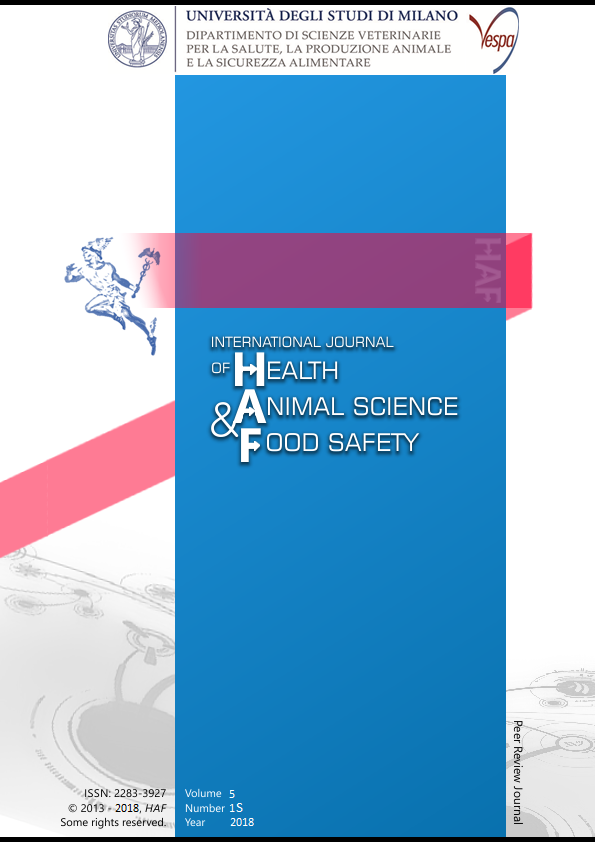Abstract
Bovine besnoitiosis, caused by Besnoitia besnoiti, is a (re)emerging disease in Europe (Cortes et al., 2014), including Italy (Gazzonis et al., 2014; 2017). However, its economic impact is scarcely considered and generally underestimated and there are still little studied aspects concerning both the parasite and the disease. Following a natural outbreak of besnoitiosis in a dairy herd, a study was planned to characterize B. besnoiti infection in cattle through a multidisciplinary approach.
Suspicious abortions and clinical cases of besnoitiosis were reported in a dairy farm (September 2017, Northern Italy) housing 216 Holstein cattle. Blood samples were collected; haematological and serological analyses (ELISA and confirmatory WB) were performed (Fernandez-Garcia et al., 2009). Histology and molecular (endpoint ITS-1 PCR (Cortes et al., 2007) and sequencing) analyses of tissues from a slaughtered cow with chronic besnoitiosis were carried out.
Out of 59 ELISA-positive animals, 50 (23%) were confirmed by WB. B. besnoiti prevalence was higher in cows (41%) than in calves (12%); any heifer did not result positive. Considering haematological parameters, a significant shift in the differential leucocyte formula from lymphocyte to granulocyte was recorded in infected cows (Mean±S.D.:L=46.1±18.4,G=53.9±18.4) if compared to negative animals (Student’s T-test,p=0.012). This finding could be helpful in diagnosis, treatment and control of besnoitiosis. Histology revealed a high load of B. besnoiti tissue cysts in skin, vulva, muzzle, sclera, eyelid, respiratory tract, emphasizing the possibility of parasite transmission through direct contact among animals. B. besnoiti was confirmed by PCR in other organs (heart, liver, aorta wall, tonsil) and especially in ovary, uterus and vulva, suggesting that the infection could affect cows’ fertility. Parasite DNA was also found in masseters posing an important question for food security, even if B. besnoiti is not considered zoonotic. The study suggests that to investigate the dynamics of bovine besnoitiosis is mandatory associate clinical and laboratory tests, including the genetic characterization of the parasite and its eventual correlation with the disease outcome.
Riferimenti bibliografici
Cortes, H.C., Reis, Y., Gottstein, B., Hemphill, A., Leitao, A., Muller, N., 2007. Application of conventional and real-time fluorescent ITS1 rDNA PCR for detection of Besnoitia besnoiti infections in bovine skin biopsies. Veterinary Parasitology. 146, 352-356.
Cortes, H.C., Leitao, A., Gottstein, B., Hemphill, A., 2014. A review on bovine besnoitiosis: a disease with economic impact in herd health management, caused by Besnoitia besnoiti. Parasitology. 141, 1406-1417.
Fernandez-Garcia, A., Alvarez-Garcia, G., Risco-Castillo, V., Aguado-Martinez, A., Marugan-Hernandez, V., Ortega-Mora, L.M., 2009. Pattern of recognition of Besnoitia besnoiti tachyzoite and bradyzoite antigens by naturally infected cattle. Veterinary Parasitology. 164, 104-110.
Gazzonis, A.L., Alvarez-Garcia, G., Zanzani, S.A., Garippa, G., Rossi, L., Maggiora, M., Dini, V., Invernizzi, A., Luini, M., Tranquillo, V.M., Ortega-Mora, L.M., Manfredi, M.T., 2014. Besnoitia besnoiti among cattle in insular and northwestern Italy: endemic infection or isolated outbreaks? Parasite and Vectors. 7, 585.
Gazzonis, A.L., Alvarez-Garcia, G., Maggioni, A., Zanzani, S.A., Olivieri, E., Compiani, R., Sironi, G., Ortega-Mora, L.M., Manfredi, M.T., 2017. Serological dynamics and risk factors of Besnoitia besnoiti infection in breeding bulls from an endemically infected purebred beef herd. Parasitology Research. 116, 1383-1393.
This work is licensed under a CC BY-SA 4.0 international

